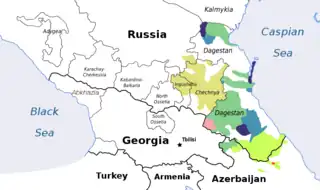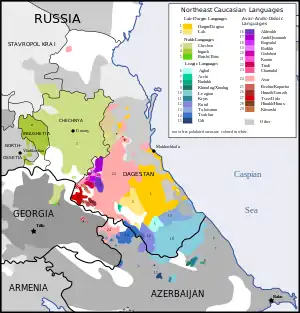Avar–Andic languages
The Avar–Andic languages form one of the seven main branches of Northeast Caucasian language family. It branches into the Andic languages and the Avar language. The latter, with 800,000 speakers, serves as a literary language for 60,000 speakers of the Andic branch as well as for speakers of the related Tsezic (Didoic) languages.
| Avar–Andic | |
|---|---|
| Geographic distribution | Dagestan |
| Linguistic classification | Northeast Caucasian
|
| Proto-language | Proto-Avar-Andic |
| Subdivisions | |
| Glottolog | None |
 Avar–Andic | |
The table below shows regional dialects encompassed in the Avar-Andic languages, as well as other language groups in the Northeast Caucasian language family.[1][2] Included are the Andic language, Akhvakh language, Bagvalal language, Botlikh language, Chamalal language, Godoberi language, Karata language, Tindi language, and Avar language.[3]

Main areas of Northeast Caucasian languages
See also
References
- Concise Encyclopedia of Languages of the World. Elsevier. 2010-04-06. ISBN 978-0-08-087775-4.
- "Caucasian Languages". georgehewitt.net. Retrieved 2022-12-13.
- "Avar alphabet, language and prounciation". omniglot.com. Retrieved 2022-12-13.
This article is issued from Wikipedia. The text is licensed under Creative Commons - Attribution - Sharealike. Additional terms may apply for the media files.
